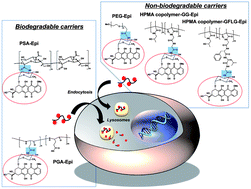Polysialic acid as a drug carrier: evaluation of a new polysialic acid–epirubicin conjugate and its comparison against established drug carriers
Abstract
This paper explores the potential of

* Corresponding authors
a
Reading School of Pharmacy, University of Reading, Whiteknights, RG6 6AD, Reading, UK
E-mail:
f.greco@reading.ac.uk
Fax: +44 (0)118 378 4703
Tel: +44 (0)118 3788244
b
Department of Pharmaceutical and Pharmacological Sciences, University of Padua, Via F. Marzolo 5, 35131 Padua, Italy
E-mail:
gianfranco.pasut@unipd.it
Fax: +39 049 82765366
Tel: +39 049 8275694
This paper explores the potential of

 Please wait while we load your content...
Something went wrong. Try again?
Please wait while we load your content...
Something went wrong. Try again?
F. Greco, I. Arif, R. Botting, C. Fante, L. Quintieri, C. Clementi, O. Schiavon and G. Pasut, Polym. Chem., 2013, 4, 1600 DOI: 10.1039/C2PY20876H
To request permission to reproduce material from this article, please go to the Copyright Clearance Center request page.
If you are an author contributing to an RSC publication, you do not need to request permission provided correct acknowledgement is given.
If you are the author of this article, you do not need to request permission to reproduce figures and diagrams provided correct acknowledgement is given. If you want to reproduce the whole article in a third-party publication (excluding your thesis/dissertation for which permission is not required) please go to the Copyright Clearance Center request page.
Read more about how to correctly acknowledge RSC content.
 Fetching data from CrossRef.
Fetching data from CrossRef.
This may take some time to load.
Loading related content
